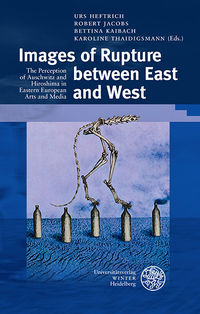
Images of Rupture between East and West
The Perception of Auschwitz and Hiroshima in Eastern European Arts and Media
1. Edition, 2016
547 Pages
ISBN: 978-3-8253-6548-6
Product: Book
Edition: Hardcover
Subject: Slavistik
Series: Beiträge zur neueren Literaturgeschichte [Dritte Folge], Volume No.: 347
Available: 29.09.2016
Keywords:
Geschichtsschreibung, Historiographie, Erinnerungskultur, Holocaust, Osteuropa, Friedensbewegung, Politisierung, Sowjetunion, Filmwissenschaft, Hiroshima, Nagasaki, Zivilisationsbruch, Atombombenabwürfe, Ost-West, Nachkriegsfilm, Tschechische Republik, Jugoslawien, Katastrophenrezeption
In spite of the incommensurability of the Holocaust and the dropping of the first atomic bombs, the juxtaposition of Auschwitz and Hiroshima has long been a topic of serious debate. While in public memory on both sides of the Iron Curtain Auschwitz and Hiroshima have become icons of industrialized mass murder, comparative research on this iconization has been dominated by decidedly Western perspectives. Moreover, the fact that in communist Eastern Europe the interpretation of these two events differed considerably from their treatment in the West has been largely neglected. Thus, in communist Eastern Europe, with its ideology based on historical optimism, the concept of rupture was either ignored or dismissed as Western defeatism, whereas in Western thinking, both Auschwitz and Hiroshima have often been seen as fundamental ruptures that shook the foundations of civilization. In their contributions to this volume, historians, art historians, film scholars, and literary scholars investigate the perception of Auschwitz and Hiroshima in Eastern Europe from a wide range of disciplines and from cultural as well as medial perspectives.
Contrib. by: Ran Zwigenberg, Makiko Takemoto, Robert Jacobs, Bettina Hofmann, Felicitas Fischer von Weikersthal, Mirjam Rajner, Bettina Kaibach, Christoph Garstka, Renata von Maydell, Marlene Bainczyk-Crescentini, Karoline Thaidigsmann, Anna Ziębińska-Witek, Friederike Gürbig, Zuzana Jürgens, Urs Heftrich, Tvrtko Jakovina, Vesna Cidilko, Zrinka Božić Blanuša, Cristina Beretta, Dragan Kujundžić, Jiří Holý, Veronika Ambros, Oksana Bulgakowa, Dorothea Redepenning
""
Natali Stegmann in: Jahrbücher für Geschichte Osteuropas, jgo.e-reviews 8 (2018)/4, S. 37-41, URL: https://www.recensio.net/r/13ac738b787a4ec9b16282f92cab08d3
""
Ekaterina Makhotina in: Bohemia, 59.1 (2019), 210-212, DOI: https://doi.org/10.18447/BoZ-2019-8197
""
Danuta Batorska in: The Polish Review, 63.3 (2018), 76ff
""
Irena Grudzińska Gross in: Slavic Review, Vol. 77.3 (2018), 812f
""
Hiroaki Kuromiya in: The Russian Review, Vol. 76 (2017), No. 4, 773f
""
Jan Hansen in: H-Soz-Kult, 04.07.2017, URL: http://www.hsozkult.de/publicationreview/id/rezbuecher-26896
Inhalt (PDF 328kB)




